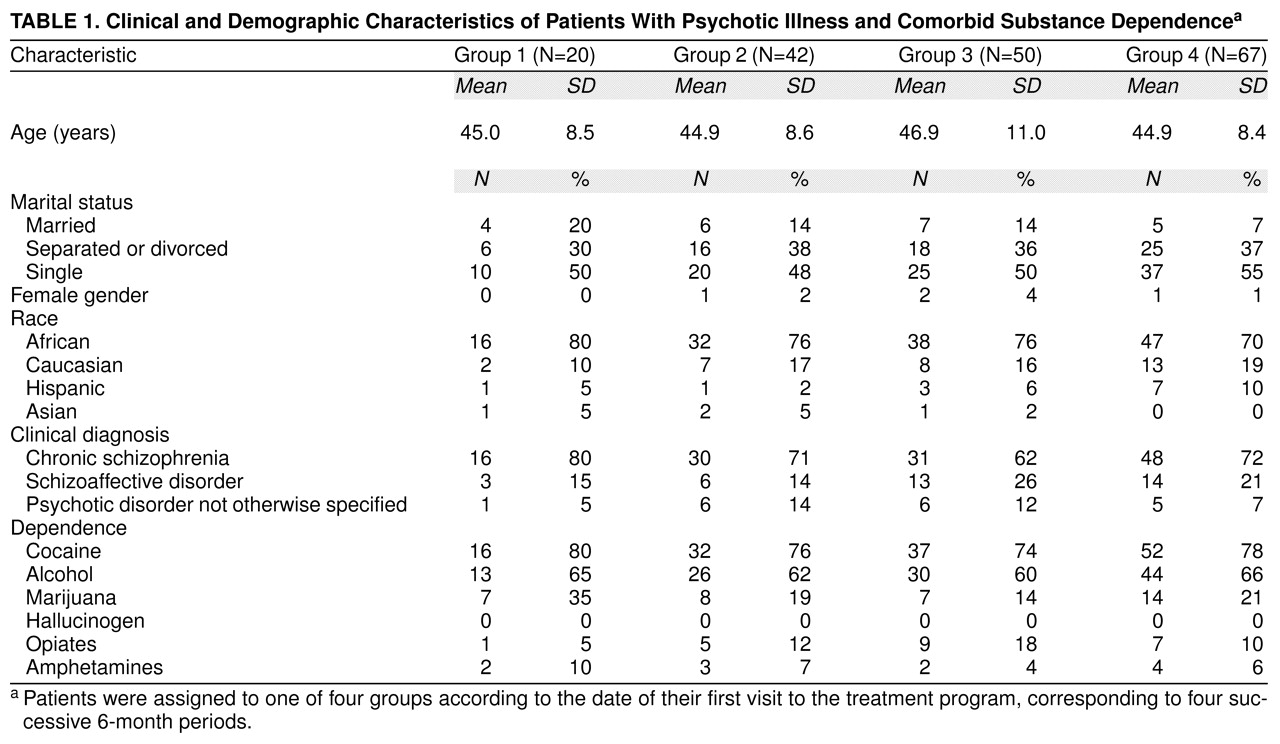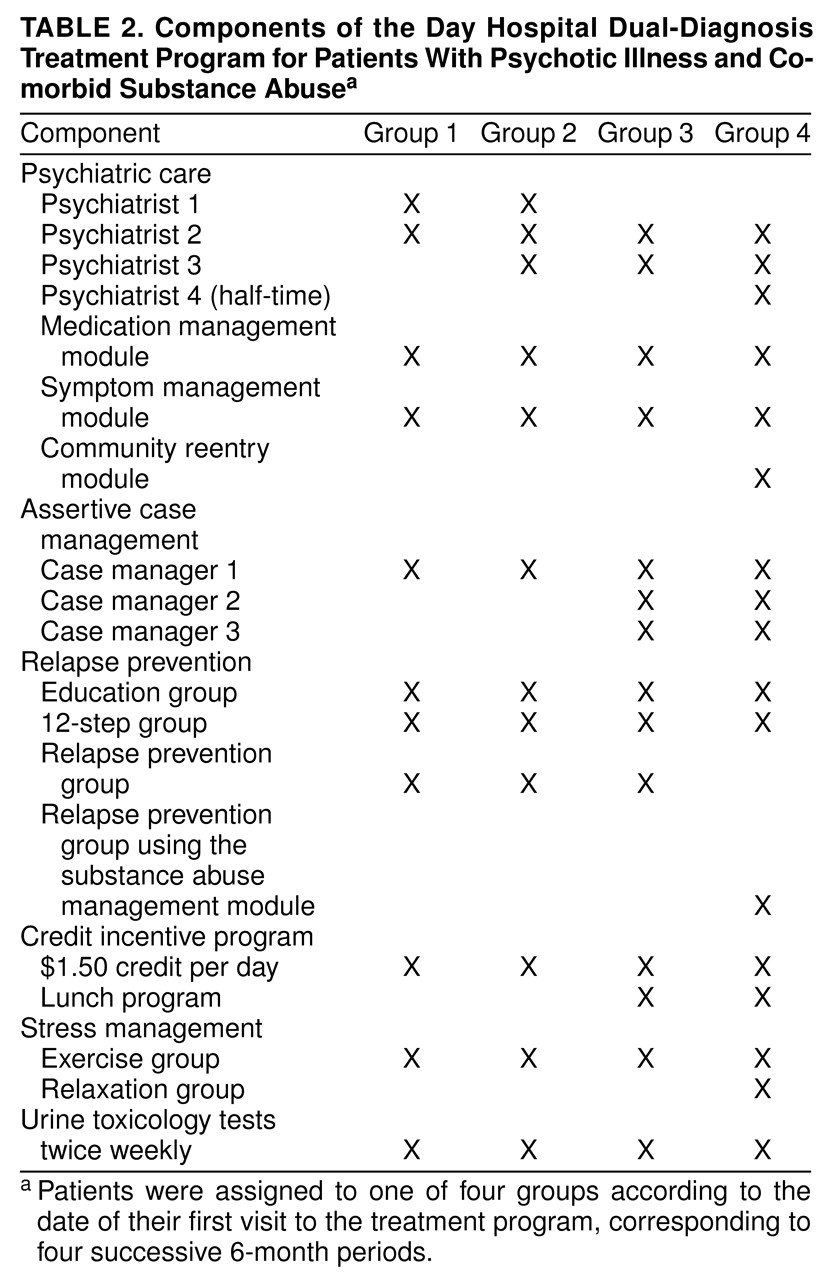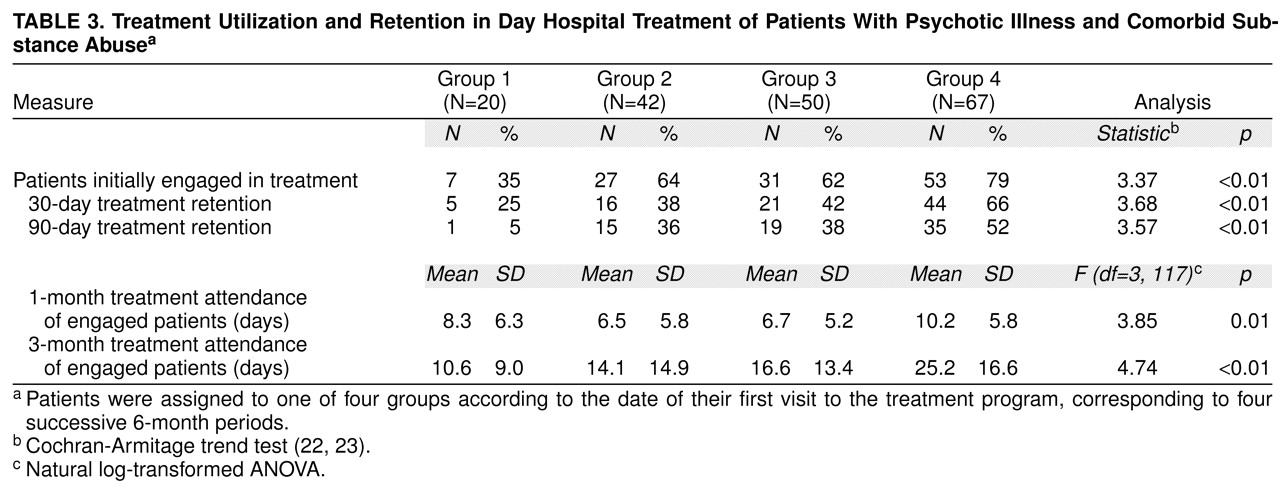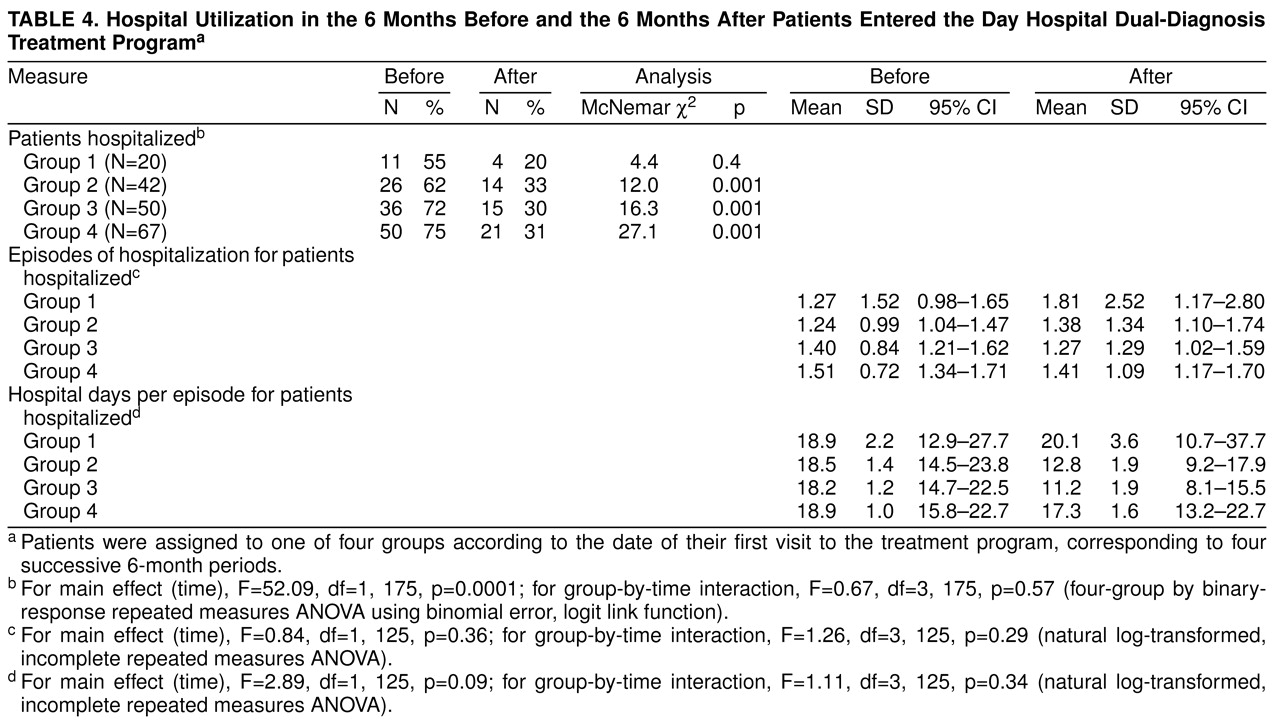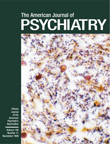Comorbid substance abuse in patients with chronic psychotic illness adds to the challenges facing their successful rehabilitation. Increased morbidity from substance-induced psychotic exacerbation, dysphoria, anxiety, insomnia, and agitation has been documented
(1). Poor retention in outpatient treatment and recurrent need for hospitalization disrupt rehabilitation efforts. Traditional treatment approaches have been unable to modify the course of illness for the majority of these patients
(2–
4). Given these challenges and an estimated lifetime prevalence of substance abuse of 47% among patients with schizophrenia
(5), there has been increasing interest in developing effective treatment for these dually diagnosed patients
(4,
6–
12).
Although several studies of treatment for substance abuse included patients with chronic psychotic illnesses, only four published reports
(6–
8,
13) have described specific treatment outcomes for this population. The results from these studies were constrained by small sample sizes and reliance on self-reported sobriety status. The reported treatment outcomes were notable for the low treatment retention at 3 and 6 months and the low rates of sobriety for the patients who had a comorbid nonalcoholic substance disorder.
Diverse approaches to the treatment of this population have been proposed. Several programs have adopted cognitive behavioral therapy oriented toward relapse prevention
(6–
8,
14,
15). The prevailing rationale for deviations from the traditional 12-step approach has been the impression that many patients with chronic psychotic illness were unable to tolerate the confrontational and abstract spiritual approach. In addition, the applicability of the strict self-help requirement for these severely mentally ill patients has been questioned. Some of the treatment programs supplemented self-help by providing integrated case management and psychiatric care
(4). These treatment programs varied in intensity from weekly group therapy to intensive inpatient treatment of 6 months’ duration
(10). The scope and intensity of case management and degree of integration of psychiatric care and relapse prevention treatment also varied among treatment programs. Despite these differences, initial reports from these innovative programs supported the feasibility of providing these interventions
(4,
16).
Variations in the choice of treatment components and intensity of intervention can be attributed to the early developmental phase of the integrated treatment approach. Data supporting the inclusion of specific treatment components and optimal treatment intensity have been lacking
(13,
16). Without assessment of the contribution by individual program components, evaluative studies are of limited use in guiding the further refinement and development of integrated treatment programs.
The dual-diagnosis treatment program at the West Los Angeles Veterans Affairs (VA) Medical Center was established in 1990 to develop rehabilitative services for patients with chronic psychotic illnesses and comorbid substance dependence
(17–
19). Although the treatment program began operations in 1990, implementation of many of the desired program components was delayed until 1995 and 1996 as a result of administrative obstacles. We designed the current study to determine the contribution of newly added program components to the effectiveness of the day hospital program. A sequential group design allowed the comparison of program effectiveness over time as we incrementally approximated our originally proposed program. If our conceptualization of an effective program was correct, then patient engagement, treatment attendance, and sobriety maintenance would increase, while psychiatric hospital utilization would decrease, in successive groups entering the day hospital program between 1994 and 1996.
METHOD
Patients with chronic psychotic disorder and comorbid substance dependence were referred for enrollment in the dual-diagnosis treatment program from the emergency department, psychiatric inpatient units, and outpatient psychiatric clinics of the VA Medical Center. A special request for referral of patients with comorbid cocaine dependence was made through recruitment memos and flyers to maximize the inclusion of these patients.
We prospectively examined the 6-month treatment engagement and outcome of four groups successively enrolled over a 2-year period in the day hospital of the dual-diagnosis treatment program. We divided the 2 years from Sept. 1, 1994, to Aug. 31, 1996, into four successive 6-month periods. Patients’ data were entered into an analysis based on intent to treat; that is, data from all patients who had at least one visit to the day hospital were included. The patients were assigned to one of the four groups on the basis of the date of their first visit. Group 1 included all patients entering Sept. 1, 1994, to Feb. 28, 1995; group 2 included all patients entering March 1, 1995, to Aug. 31, 1995; group 3 included all patients entering Sept. 1, 1995, to Feb. 29, 1996; and group 4 included all patients entering March 1, 1996, to Aug. 31, 1996.
We excluded patients who had been previously treated at the day hospital, as indicated by any visit to the day hospital logged between Jan. 1, 1990, and Sept. 1, 1994. This procedure prevented the contamination of current treatment effect by prior day hospital treatment.
All patients (N=179) were veterans eligible for care at the West Los Angeles VA Medical Center. Clinical diagnoses were made by the treating psychiatrists using DSM IV criteria. The clinical and sociodemographic characteristics of the subjects are shown in
table 1. There were no statistically significant differences among the four groups in marital status, gender, race, and clinical diagnoses. As would be expected from a population of dually diagnosed U.S. veterans, 98% of the patients were male; most were unmarried, and most of them had an axis I diagnosis in the schizophrenia spectrum. We used psychiatric hospital utilization in the 6 months before entry into the day hospital program as an indirect measure of the patients’ pre-entry severity of illness; there were no statistically significant differences between the groups.
Treatment
We conceptualized integrated psychiatric care as using a single physical location, with primary treatment teams providing both inpatient and outpatient mental health and substance treatment services. All patients were encouraged to attend the day hospital phase of treatment. Relapse prevention training was conducted through a series of skills training groups that emphasized the mastery of specific social skills, which could reduce the frequency and severity of relapse. This 35-session training program, the substance abuse management module, is aimed at overcoming the obstacles posed by cognitive and social skills deficits found in patients with schizophrenia. An additional two sessions of skills practice were provided each week to enhance and maintain these skills. A manual-driven version of this treatment module was implemented starting with group 4.
The major program components that were available during each of the four 6-month periods are summarized in
table 2. Starting with group 3, with the addition of two case managers, we were able to increase the intensity of assertive case management functions (e.g., housing and advocacy services) that were localized within each of the three day hospital treatment teams
(20). Starting with group 3, we also provided free lunch to patients who attended the day hospital each day. All psychoeducational group sessions lasted 45 minutes, and patients received credit for attending each session and for providing twice weekly urine samples for toxicology testing. Urine toxicology results and program attendance records were discussed with each patient individually and during treatment team meetings. We prescribed psychotropic medications for relief of specific symptoms. In addition, disulfiram was available to patients with comorbid alcohol dependence. None of the patients received clozapine or olanzapine during the study period, and few patients received risperidone. There was no significant difference in the very limited use of risperidone by patients before versus after their entry into the day hospital program. The medication management strategy was not modified over the study period; haloperidol and fluphenazine were the predominant antipsychotic agents prescribed.
Outcome Measures
Treatment attendance records were entered daily into a centralized electronic medical record database by clerical staff for all patients who attended the treatment program each day. We reviewed the medical records database at West Los Angeles VA Medical Center to obtain the number of psychiatric admissions and dates of hospitalization for each patient in the 6 months before and the 6 months after the start of treatment at the day hospital. Inpatient psychiatric bed-days for the period 6 months before and after starting the day hospital program were tabulated for each patient. We included only psychiatric inpatient care at the West Los Angeles VA Medical Center in this analysis.
Urine samples were collected and analyzed twice weekly. An assigned nursing staff member collected urine samples under direct visual supervision. Urine toxicology analyses were performed according to a previously reported method
(21). The drugs of abuse screened were marijuana (in the form of Δ-9-tetrahydrocannabinol), barbiturates, cocaine (in the form of the major metabolite, benzoylecgonine), amphetamine, and opioids (in the form of morphine).
Data Analysis
Analyses of the data proceeded in five steps for each of the four groups. The first analysis examined the patients’ initial engagement in treatment. In this analysis, we defined initial treatment engagement as attending the day hospital program at least 2 days in the first 30 days of enrollment. We calculated the initial engagement rate as the number of patients who were engaged in treatment as a percentage of all patients in each group. The second analysis examined the days of day hospital attendance for the patients who were engaged in treatment. We calculated 1-month treatment “dose” as the number of days of attendance in the first 30 days of treatment and 3-month treatment dose as the number of days of program attendance during first 3 months of the follow-up period. These last two variables served as measures of sustained participation in the day hospital program.
Since all patients were treated with antipsychotic medication, and we dispensed no more than a 1-month supply of medication at each visit, patients who did not return at least once every 30 days were very likely to be noncompliant and inadequately treated. In the third analysis, we examined the level of compliance with follow-up treatment after the first month in the program. We defined 30-day treatment retention as returning for treatment at least once in the 30 days after the first 30 days of entering the day hospital program; 90-day treatment retention was similarly defined, except it was calculated using those patients who continued in treatment for at least one day in the 30 days after the first 90 days of entering the day hospital program.
In the fourth analysis, we examined the impact of program enrollment on psychiatric hospitalization by comparing episodes and days of hospitalization in the 6 months before and the 6 months after entry into the day hospital program. We determined the percentage of patients in each group who had any hospitalization during that time interval. For the patients with any hospitalization, we calculated the mean number of episodes and the mean number of days per episode of hospital utilization.
Finally, we compared the sobriety status of each group during each month of the 6-month follow-up period. We defined maintenance of sobriety for any given month as providing two or more drug-free urine samples and no drug-positive urine sample during that month. We calculated the sobriety rate for each group as the number of patients who achieved this sobriety criterion in that month divided by the total number of patients in that group.
We used SPSS 7.0 for Windows (SPSS, Chicago) and SAS version 6.12 (SAS Institute, Cary, N.C.) for statistical calculations. We used the Pearson chi-square test for comparisons of categorical variables between groups and the McNemar chi-square test for comparisons of hospitalization rates before and after treatment within each group. The Cochran-Armitage trend test (SAS Proc Freq)
(22,
23) was used for the hypothesized trend of increased treatment retention from group 1 to group 4. We used repeated measures analysis of variance (ANOVA) for binary variables (GLIMMIX SAS Macro) and continuous variables (General Linear Model, SAS Proc MIXED). We used natural log transformation for dose of treatment and episodes and days of hospitalization.
RESULTS
As shown in
table 3, the initial treatment engagement rate, the mean number of days of attendance, and the treatment retention rate in the day hospital program all showed sequential improvements from group 1 to group 4. Statistically significant comparisons and interactions are also depicted in
table 3. The engagement, attendance, and retention rates were the best in group 4, as we hypothesized, since that group experienced the fullest spectrum of treatment components in comparison with the other three groups. Also, as predicted, we found the greatest pairwise differences in engagement, attendance, and retention between group 4 and group 1.
As shown in
table 4, the reduction in psychiatric hospital utilization occurred among patients who did not require rehospitalization after entry into the day hospital program. For the patients with at least one hospitalization after entry into the day hospital program, there was no reduction in the number of episodes or days of hospitalization.
An increasing percentage of patients from group 1 to group 4 maintained sobriety for at least 1, 2, 3, and 4 months in the first 6 months of treatment (Cochran-Armitage trend test statistic: 1 month, 2.16, p=0.03; 2 months, 4.26, p=0.01; 3 months, 6.37, p=0.001; 4 months, 2.02, p=0.04). Sixty percent of the patients in group 4 maintained sobriety for at least 1 month, compared with 30% of the patients in group 1. Thirty-one percent of the patients in group 4 maintained sobriety for at least 3 months, compared with only 5% of the patients in group 1. In the sixth month of treatment, 20% of the patients in group 4 were sober, compared with none in group 1. Groups 2 and 3 were intermediate between groups 1 and 4 in the proportion of patients who maintained sobriety.
DISCUSSION
The improvements noted in engagement, treatment participation, and sobriety supported the hypothesis that the program changes during 1995 and 1996 led to greater program effectiveness. Among the many changes, the increase in intensity of assertive case management and the increasing experience and competence of the staff in the implementation of biobehavioral elements may have been the two most important changes related to the sequential improvements in outcome from group 1 to group 4. In conjunction with integrated psychiatric care, assertive case management enhanced the engagement process by maximizing patients’ access to social and rehabilitative resources. Once engaged in treatment, patients were more likely to receive medication services and training in relapse prevention skills. Although the two additional case managers arrived during the time of group 3, their case management abilities increased during the initial months of their training, with a latency in the full impact of their efforts until group 4.
Program attendance during the first month in the day hospital program was one major determinant of the patients’ opportunity to acquire the skills taught in the program’s psychoeducational groups. Thus, with the enhanced deployment of assertive case management in group 4, patients may have derived increased therapeutic benefits through improved attendance. For example, a subgroup of 16 patients in group 4 who successfully completed the substance abuse management module attained significantly increased knowledge and social skills, while self-reported days of cocaine use significantly decreased in the 30 days after completion in comparison with the 30 days before entry into the day hospital program
(17). In addition to the full implementation of the substance abuse management module in group 4, the incremental improvements in content and staff expertise in teaching it from group 1 to group 4 may have contributed to the observed outcome improvements.
While psychiatric hospital utilization decreased for all four groups following enrollment in the day hospital program, we did not find any significant differences among the groups in hospital utilization in the 6 months after day hospital program enrollment. Although this may have been related to a trend toward a higher pre-enrollment rate of hospital utilization in group 4 in comparison with group 1, there were other possible explanations. For example, as the treatment retention rate rose in the later groups, it is possible that some of the patients who would not have been engaged in treatment if they had been in group 1 were successfully engaged in treatment because they were part of group 4. The psychiatric hospital utilization of these more difficult-to-engage patients, once engaged in treatment, might have been higher than that of the more easily engaged patients. In addition, the engagement process may have modified the help-seeking behavior of these patients. The higher hospital utilization by this more severely ill group may have offset the reduction in hospital utilization of the patients who did not require hospitalization.
Since the objective of this project was to assess the changes in program performance over time, we compared patients grouped by date of entry into the day hospital program. This design requires specific cautions in the interpretation of results, because it relies on two assumptions: group uniformity and a causal relationship between programmatic elements and outcome.
The first caution relates to the possibility that patients entering the day hospital program may have differed from group to group. Although the day hospital admission criteria and patient demographic and diagnostic variables were stable over the four groups, we cannot be fully certain that this is a complete set of relevant characteristics. We attempted to maintain diagnostic homogeneity by including only patients with a DSM-IV diagnosis of chronic schizophrenia, schizoaffective disorder, or psychotic disorder not otherwise specified (if schizophrenia or schizoaffective disorder could not be excluded because of an insufficient period of sobriety). In our previous study of patients with chronic psychotic disorders who were admitted for inpatient treatment at this hospital
(24), definitive diagnosis was possible for only 25% of the patients despite the use of a structured diagnostic procedure (Structured Clinical Interview for DSM-IV Axis I Disorders, Patient Edition), even when repeated 18 months after the initial assessment. In 78% of the diagnostically uncertain cases, the cause of uncertainty was an insufficient period of sobriety.
The second caution relates to the causal inference that the reported outcome improvements are linked to changes in the day hospital program. Without a concurrent control group, we are unable to exclude the effect of temporally correlated factors not specific to the day hospital program. Some examples of possible confounding factors include changes in the availability of community residential resources and advances in pharmacological treatment. However, it is important to note that it is impractical to construct multiple controlled studies to test the additive benefit of each component in an integrated treatment program. It is also unethical to withhold treatment components that are known to be efficacious from previous controlled studies.
The relatively short 6-month follow-up period is another potential limitation. However, it is likely that this similarly biased the results from all four groups, and thus comparisons among the groups remain valid.
The steep decline in treatment retention and sobriety during the first 6 months of treatment in all groups indicates that further refinements in the treatment of these patients are needed. An important implication of this observation is that our ambition in achieving satisfactory treatment outcome at 1-year follow-up must be preceded by the successful development of a program capable of achieving effective retention and treatment during the first 6 months.
In complex psychosocial treatment programs, the stability of program performance over time can never be fully ensured. Both intended and unintended program modifications will inevitably affect program performance. As program components were modified or added, it was often with the hope that these changes would favorably affect treatment effectiveness. Monitoring of program performance based on a key set of outcome measures is necessary for the cost-effectiveness assessment of these program changes. In this study, we demonstrated the feasibility of conducting a clinical program evaluation over a 2-year period without reliance on research funding. We expect that the method we described can be useful in the evaluation of other complex treatment programs.
This is the largest study, to our knowledge, of treatment outcome in patients suffering from chronic psychotic illnesses and comorbid substance dependence. The results of the study suggest that our integrated approach became increasingly effective in the early stages of treatment. The treatment program we have described is undergoing active development, and we hope that the continued refinement of our methods will achieve increasingly better outcomes for our patients. We also hope that this report will stimulate efforts by others to report their experiences with these challenging patients.
